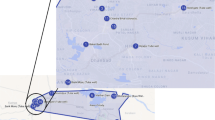Abstract
The physio-chemical and chemical features of water in natural conditions are controlled by the weathering of bedrocks, local climate, landforms and other geo-environmental parameters. In order to understand the characteristics of water and the origins of the dissolved loads in the rivers and in the ground waters of the Taklimakan Desert, western China, we studied the ions in the water samples collected from rivers and wells. We collected water samples from four rivers (Keriya River, Cele River, Tumiya River and Yulongkashi River) in the southern desert and ground water samples from many parts of the desert. Major cations and anions were measured using ion-chromatograph and titration with HCI. The total dissolved solids (TDS), pH and conductivity were examined on site by a portable multi-parameter analyzer. The data show that the water in the rivers of southern Taklimakan is still of fresh water quality and slight alkalinity, although the TDS is comparatively higher than that of many other rivers of the world. The ground water is fresh to slightly saline, with TDS a little higher than that of river water in the study area. The concentration of ions is slightly different between the four rivers in the southern Taklimakan. However, the chemistries of ground water in all samples are to a large degree controlled by sodium and chloride. The ions in the ground water are concluded to be mainly from dissolving of evaporites, consistent with the dry climate in the region, whereas the ions in the rivers are mainly from rock weathering. Low-level human imprints are recognized in the ground water samples also.
Similar content being viewed by others
References
Berner E K, Berner R A. The Global Water Cycle: Geochemistry and Environment. New Jersey: Prentice-Hall, 1987
Holland H D. The Chemistry of the Atmosphere and Oceans. New York: John Wiley, 1978. 111–125
Taklamakan Expedition Team of the Chinese Academy of Sciences. The Climate in the Taklamakan Desert (in Chinese). Beijing: Science Press, 1993. 3–10
Tibet Expedition Team of Chinese Academy of Sciences. Geological Evolutions in the mountains of Kalakunlun and Kunlun (in Chinese). Beijing: Science Press, 2000. 6–9
Zhu Z D, Chen Z P, Wu Z, et al. Studies on Aeolian Landforms in the Taklamakan Desert (in Chinese). Beijing: Science Press, 1981. 1–4
Xinjiang Expedition Team of the Chinese Academy of Sciences, Institute of Geology of the Chinese Academy of Sciences, Xinjian Branch of the Chinese Academy of Sciences. Groundwater in Xinjiang (in Chinese). Beijing, Science Press, 1965. 25–32
Fitts C R. Groundwater Science. Amsterdam: Academic Press, 2002. 285
Sarin M M. Krishnasswami S. Major ion chemistry of the Ganga-Brahamputra river systems, India. Nature, 1984, 312: 538–541
Gibbs R J. Mechanisms controlling world water chemistry. Science, 1970, 170: 1088–1090
Gibbs R J. Mechanisms controlling world water chemistry: evaporation-crystallization process. Science, 1971, 172: 871–872
Meybeck M. Global chemical weathering of surficial rocks estimated from river dissolved loads. Am J Sci, 1987, 287: 401–428
Chen J S, Wang F Y, Xia X H, et al. Major element chemistry of the Changjiang (Yangtze River). Chem Geol, 2002, 187: 231–255
Ahmad T, Khanna P P, Chakrapani G J, et al. Geochemical characteristics of water and sediment of the Indus river, Trans-Himalaya, India: constrains on weathering and erosion. J Asian Earth Sci. 1998. 16: 333–346
Roy S, Gaillardet J, Allegre C J. Geochemistry of dissolved and suspended loads of the Seine River, France: anthropogenic impact, carbonate and silicate weathering. Geochim Cosmochim Acta, 1999, 63: 1277–1292
Yang X. Chemistry and late Quaternary evolution of ground and surface waters in the area of Yabulai Mountains, western Inner Mongolia, China. Catena, 2006. 66: 135–144
Liu Y J, Cao L M, Li Z L, et al. Geochemistry of Elements (in Chinese). Beijing: Science Press, 1984. 439–441
Author information
Authors and Affiliations
Corresponding author
Additional information
Supported by the National Natural Science Foundation of China (Grant Nos. 40425011 and 40671020)
About this article
Cite this article
Zhu, B., Yang, X. The ion chemistry of surface and ground waters in the Taklimakan Desert of Tarim Basin, western China. CHINESE SCI BULL 52, 2123–2129 (2007). https://doi.org/10.1007/s11434-007-0298-6
Received:
Accepted:
Issue Date:
DOI: https://doi.org/10.1007/s11434-007-0298-6




